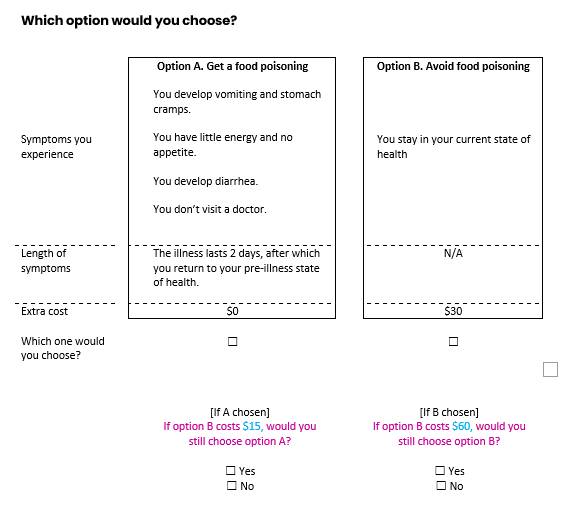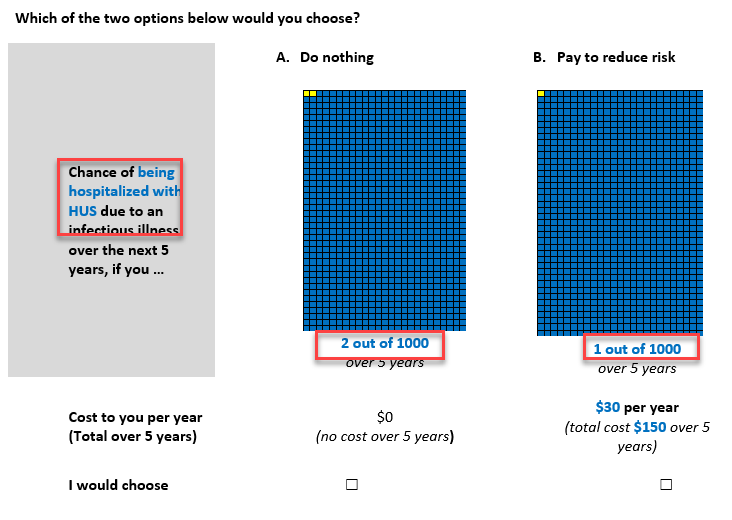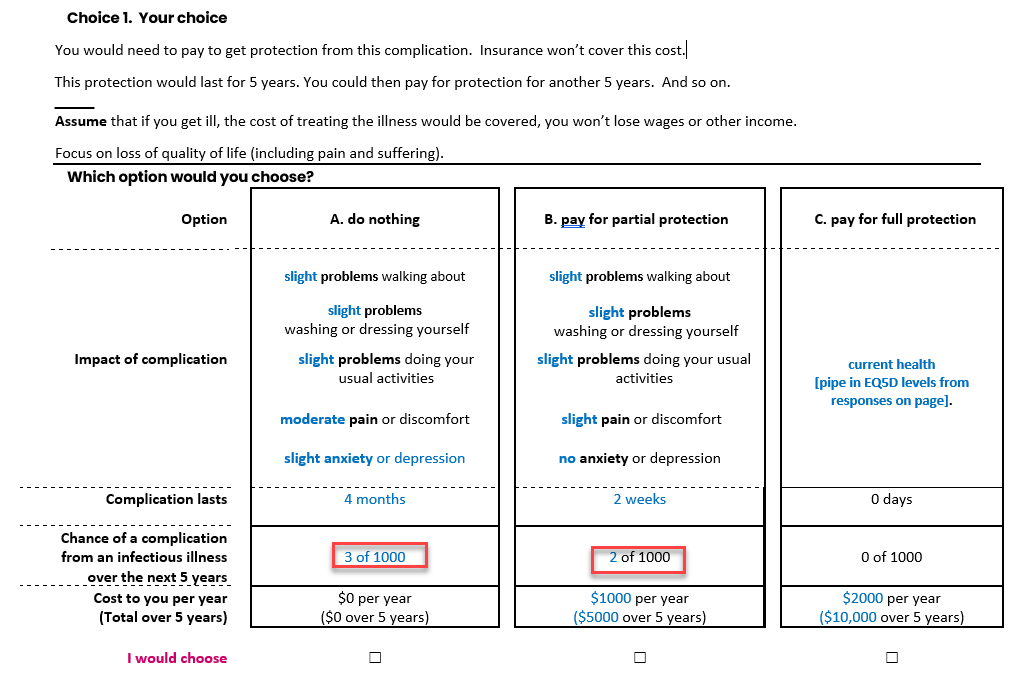Appendix 6. US Foodborne Illness WTP Survey_Discrete Choice Experiment Design
Appendix 6. US Foodborne Illness WTP Survey_Discrete Choice Experiment Design.docx
Generic Clearance for Survey Research Studies
Appendix 6. US Foodborne Illness WTP Survey_Discrete Choice Experiment Design
OMB: 0536-0073
OMB Control Number: 0536-0073
Exp. Date: 04/30/2025
U.S. Adult Food Poisoning Outcomes Survey
Appendix 6. Discrete Choice Experiment Attributes and Levels
The Acute survey will have 5 choices using symptom descriptions as attributes and 5 choices using EQ5D attributes.
Each Acute symptom-based choice will have the 8 attributes presented in the table below. The levels of the attributes will differ across respondents in keeping with an optimal discrete choice experiment design.
Symptom-based attributes for choice sets (acute version).
Attribute |
Levels |
Vomiting |
None |
Present |
|
Stomach cramps |
None |
Present |
|
Diarrhea |
None |
present, non- bloody |
|
present, bloody |
|
Fever |
none |
present |
|
Headache |
none |
present |
|
Dr visit |
None |
you visit your family doctor once, who tells you to rest, drink plenty of fluids and take Tylenol or ibuprofen for pain. |
|
you visit your family doctor twice, who tells you to rest, drink plenty of fluids and take Tylenol or ibuprofen for pain. |
|
Duration |
the illness lasts for ‘x’ days. (x=1,2,4,7,10,14 days) after which you are completely recovered. |
Cost ($) |
Initial bids: 30, 50, 90, 150, 300 Follow up bids: are adjusted off of the initial bids with the follow up to a no at ½ the initial bid, follow up to a yes at 2x the initial bid |
Each respondent will see 5 Choice Sets, Status Quo (SQ) (current health) + 1 (illness), with a follow up question (with higher/lower price)

1.2. The Acute version EQ5D choices have 7 attributes, seen in the table below. These choices will be constrained to avoid illnesses that are less severe than the respondents’ current health as indicated by their self-assessment using the EQ5D instrument early in the survey.
EQ5D attributes for choice sets (acute version).
Attribute |
Levels |
Mobility |
1-5 |
Self-care |
1-5 |
Usual activities |
1-5 |
Pain/discomfort |
1-5 |
Anxiety/depression |
1-5 |
Duration |
(x=1,2,4,7,10,14, 18 days) |
Cost |
18, 25, 35, 40, 50, 60, 120, 230, 300. With cost of B < cost of C |
Each respondent will see 5 Choice Sets, SQ (current health (C)) + 2 (illness options (A, B)), No follow up question:
Current health levels will be “piped in” from self-completed EQ5D-5L questions.
The DCE levels are constrained to ensure none of the 5 attributes in an Illness state (A, B) are better than the current health (C).

The Severe Outcome version of the survey will also have 5 choices using symptom descriptions as attributes and 5 choices using EQ5D attributes.
Each Severe/Chronic symptom-based choice will have 3 attributes (illness description, risk, cost) presented in the table below. The levels of the attributes will differ across respondents in keeping with an optimal discrete choice experiment design.
The Severe Outcome version has a narrative illness description as an attribute (Appendix 4). These descriptions are designed to reflect the kind of information medical professional provide to patients who are at risk for a particular illness. The descriptions include information on possible outcomes, their likelihood, health impact, and duration.
Symptom-based attributes for choice sets (severe outcome version).
Attribute |
Levels |
Illness description |
Sepsis, appendectomy, IBS, GBS, HUS, Reactive arthritis, permanent kidney failure, meningitis, H. colitis, hospitalization for GI illness, vision impairment. See Appendix 4 for illness descriptions. |
Baseline risk over 5 years |
Baseline risk is illness specific. See Appendix 4 illness descriptions. Risk reductions: 0.75, 0.5, 0.25, 0.1 times the baseline health risk over 5 years |
Cost ($)/year.
|
Hospitalized without complications: Initial bids: 20, 30, 60, 120, 250, 300 Follow up bids: are adjusted off of the initial bids with the follow up to a no of 0.5 the initial bid, follow up to a yes of 2x the initial bid Hospitalized with complications or resulting in long-term health impacts: 40, 80, 150, 240, 400, 500, 750, 1000 Follow up bids: are adjusted off of the initial bids with the follow up to a no at ½ the initial bid, follow up to a yes at 2x the initial bid |
Each respondent sees 5 Choice Sets, SQ (baseline risk) + 1 (reduced
risk) with a follow up question (with higher/lower price):


The Severe/Chronic version EQ5D choices have 8 attributes, seen in the table below. Again, these choices will be constrained to avoid illnesses that are less severe than the respondents’ current health as indicated by their self-assessment using the EQ5D instrument early in the survey.
EQ5D attributes for choice sets (severe outcome version).
Attribute |
Levels |
Mobility |
1-5 |
Self-care |
1-5 |
Usual activities |
1-5 |
Pain/discomfort |
1-5 |
Anxiety/depression |
1-5 |
Risk (x out of 1000) |
Baseline risk: 26, 17, 10, 8, 4, 2, .26, .08 out of 1000
Risk change (for options B and C): 0.75, 0.5, 0.25, 0.1 of the baseline health risk over 5 years |
Duration |
5 days, 1 week, 2 weeks, 3 months, 6 months, 1 year, 2 years, 3 years, 5 years, 8 year, 10 years, permanent |
Cost |
20, 30, 60, 120, 225, 250, 300, 400, 500, 600, 750, 1000. With cost of B < cost of C |
Each respondent will see 5 Choice Sets, SQ (current health (C)) + 2 illness options (A, B), No follow up question:
Current health levels piped into Option C from self-completed EQ5D-5L questions
The DCE levels
from the experimental design are constrained to ensure none of the 5
attributes in an Illness state (A, B) are better than the current
health (C)

| File Type | application/vnd.openxmlformats-officedocument.wordprocessingml.document |
| Author | Hoffmann, Sandra - REE-ERS, Washington, DC |
| File Modified | 0000-00-00 |
| File Created | 2024-07-20 |
© 2026 OMB.report | Privacy Policy